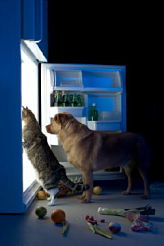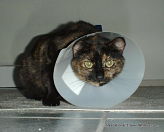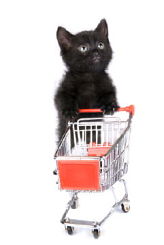Healthy Cat Fur

Healthy cat fur depends on good nutrition. Cat food and cat food supplement manufacturers are anxious to satisfy cat owners’ desire for nutritional products that promise to benefit their cats’ coats. Providing your cat with proper nutrients is an important step in maintaining its healthy cat fur.
A cat’s hair and skin are closely allied. The skin is composed of two main layers and is one of the most rapidly growing parts of the body that is constantly renewing itself.
The epidermis is the outer layer and is relatively thin. It includes the keratinized (hard) outmost layer of the skin. The dermis is located beneath the epidermis and contains many structures including sweat glands and hair follicles. The epidermis contains several cell layers which grow from the bottom up.
This eventually forms the dead outer layer of skin. As this outer layer sloughs, it is replaced by growth from below. The thickness of a cats’ skin differs depending on its location on the body surface.
Hair grows from follicles located in the dermis. Factors that alter the health of the skin might also affect the structure and function of hair follicles. A cat’s hair coat replenishes itself on a cyclical basis.
The hair growth cycle includes a growth phase called anagencatagen, and a resting phase called telogen which is when growth stops. Telogen is the terminal phase in the life of a hair resulting in the normal shedding of the hair.
A cat’s coat consists of three hair types: guard hairs, also called outer coat or primary hairs, awn hairs (secondary hairs) and down hairs (tertiary hairs). The length and color of these hairs vary among breeds. Some breeds lack specific types of hair. The concentration of the three types of hair and total hair density varies at different sites on the surface of a cats’ body.Each type of hair has a distinct microscopic anatomy. Hair is composed mostly of keratin, a protein with a high percentage of sulfur-containing amino acids. The chemical linking of these amino acids provides hair with specific properties such as expanding and shrinking when wet or dry.
Keratin is also highly concentrated in the outermost layers of the epidermis. In addition to protein, hair contains small amounts of other chemicals including chromogens (compounds that determine hair color) and trace minerals.
| Furminator Cat Shed Control Cloths |
Healthy cat fur is the result of good nutrition. If a cat’s basic diet provides the essential nutrients in amounts appropriate to the cat’s stage of life, the skin and hair should be normal, and the coat should be full, thick and lustrous. Several nutrients are particularly critical to the development of healthy cat fur.
The diet must contain adequate amounts of protein to support skin and hair regrowth. Cats have a uniquely high requirement for protein, and animal protein products provide the best balance of all essential amino acids.
Animal protein products also assure adequate amounts of the amino acid-like substance taurine, which is an essential nutrient for cats, though not of primary relevance to the healthy cat fur. Growing kittens should be fed food containing at least 30 percent protein. Foods for adult cats should include a minimum of 26% protein but I recommend choosing foods that also contain at least 30% protein.
A significant proportion of the protein should be of animal origin to ensure an adequate amount of amino acids including those sulfur-containing amino acids, for optimal skin and healthy cat fur.
The rapid growth and renewal rate of the skin and hair also requires sufficient energy. To provide adequate amounts of energy a cat’s diet has to metabolizable energy (ME). To understand ME is essential in choosing the right pet food for your cat. ME is defined as the amount of energy available from pet food once the energy lost in the feces, urine and combustible gases has been subtracted. So, it is the energy left for your pet’s body to use after digestion.
The fast growth rate of both skin and hair also requires sufficient energy so a cat’s diet should contain at least 1800 kcals of ME (Kcals are a measurement of ME) and at least 12-15% fat. Most of the fat should be of animal origin. The kcals of ME are on the package or if you find none like I did on several of the cans…you can figure it out manually by going to http://www.peteducation.com and a full description of how to do the calculation is there.
Energy-supplying fat is also a source of essential fatty acids, which are needed for the high rate of cell growth that occurs in the skin and hair. Many animals can make two of the three essential EFA’s (Essential Fatty Acids) if the third, linoleic acid is present in the diet.
Vegetable oils that contain high amounts of linoleic acid serve as adequate sources of EFA’s for these animals. Cats, however, cannot produce one of the EFA’s, arachidonic acid, from linoleic acid. Cats need animal fat in their diets to supply their need for arachidonic acid.
In addition to protein and energy, other vitamins and minerals, including Vitamin A, niacin, biotin and zinc, serve important roles in a cat’s skin and healthy cat fur. Recommendations for dietary concentrations of these nutrients are listed in the cat food profiles established by the Association of American Feed Control Officials. These profiles suggest adequate amounts to meet the needs for skin and healthy cat fur. Diets with inadequate amounts of these nutrients are not likely to pass feeding trials conducted according AAFCO protocols.
The bottom line is a quality, complete and balanced diet should provide sufficient amounts of all nutrients needed to support healthy growth of the skin and healthy cat fur in the average cat. Remember that some cats have unusual needs. Certain signs suggest deficiencies or excesses of nutrients that might affect skin and healthy cat fur.
Because skin and hair are constantly reproduced by the body, they depend on protein metabolism. A protein deficiency can cause skin and hair abnormalities. The skin becomes thinner, and the hard outer layer is more susceptible to bacterial infections. Hairs become brittle. A cessation of hair growth (anagen) resulting from protein deficiency causes the hair coat to become think and sparse.
In this scenario,
virtually all hairs remain in the telogen, or resting, phase and are not
replaced as they break or are lost through normal wear and tear. Most
commercial cat foods are complete, balanced and contain ample amounts of
protein so the possibility of a protein deficiency is unlikely in cats
fed such rations. Cats fed home prepared diets might experience protein
deficiency, depending on the types and amounts of protein used to
prepare recipes.
Energy is essential for normal cellular growth. An energy deficiency
can result in clinical signs similar to those seen in protein
deficiency. Because dietary fat content contributes to energy density,
diets low in energy is also low in fat. This essential fatty acid
deficiency is likely to accompany energy deficiency.
EFA’s are essential components of cellular membranes and precursors for many compounds that affect cellular growth. Because skin and hair are rapidly renewed, they are susceptible to EFA deficiency.
As I’ve already stated… linoleic and arachidonic acids are essential for a cat. EFA deficiency results in a dull, dry hair coat and eventual hair loss, again probably related to a cessation of hair growth. Changes in the fat content of the skin due to EFA deficiency lead to scaly, crusty skin and the potential for bacterial infections decreasing healthy cat fur results.
Skin and hair coat problems related to EFA deficiency are rare in
cats that are fed commercial diets. It is important to make sure that
such foods are not stored for long periods of time because fat can
deteriorate more rapidly than protein, particularly with improper
storage. If using home prepared diets, it is important that animal, not
vegetable fat be used as a lipid source providing an adequate supply of
the all-important arachidonic acid.
Vitamin A is needed for normal skin growth and maintenance. Insufficient intake of vitamin A can cause the hard outer layer of the skin and the hair follicles to become too thick, or hyper keratinized. Hair growth becomes abnormal or ceases. The skin becomes scaly and develops cracks that invite bacterial skin infections. The result is a thickened, crusty skin with a sparse hair coat.
Skin and hair problems are virtually unknown in cats fed commercial rations, but the administration of therapeutic amounts of vitamin A have been shown to be helpful in treating some cases of skin disease of unknown origin. A few cases of seborrhea, a skin condition characterized by greasy flaky skin, has been shown to be responsive to vitamin A therapy. However, this therapy should be done only with the supervision of your vet.
A deficiency of niacin or biotin, both water-soluble vitamins, is also associated with skin and hair problems. Niacin deficiency (pellagra) results in several clinical abnormalities including dermatitis beginning at places like the mouth, where mucous membranes join the skin. Biotin deficiency results in overgrowth of the keratinized layer particularly in areas such as the foot pads.
Historically, niacin
deficiency was seen when animals and people were maintained on diets
very high in corn or corn products. The possibility of a niacin or
biotin deficiency causing skin or hair problems in cats is extremely
remote.
Zinc deficiency also leads to abnormal development of skin and hair, again related to abnormalities in keratinization. In zinc deficiency, crust skin and hair loss appear first at pressure points and around the eyes, but gradually spread to the rest of the body.
Diets containing high concentrations of compounds that bind zinc, or substances such as calcium that interfere with zinc absorption, can also result in clinical signs of zinc deficiency. Zinc related skin disease associated with poor quality cat diets has not been reported, but there have been cases of zinc deficiency in dogs that were fed low priced rations.
Feeding a quality diet that contains protein and adequate amounts of animal fat should ensure the best possible quality healthy cat fur. But are supplements really necessary or helpful? Until a few years ago my answer to that question would have been no; a teaspoon of poultry fat added to a cat’s diet would have been as effective as most supplements.
However, information over the past few years suggests the ratio of EFA’s in the diet may affect skin health.
Related Articles......
Return from Healthy Cat Fur to Cat Health Homepage
Having trouble finding what you need? Cat Health Index & Site Map
OR
Do you have a question to ask?...Questions
OR
Do you have a cat story to share?...Simply click here to go to that page!
Copyright@2010-2020 All rights reserved.Cat-health-detective.com
This website is information only. Consult a veterinarian for medical assistance

"Like Us" on Facebook
or...
"Like Us" here




















